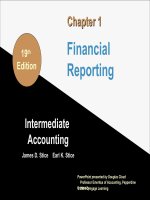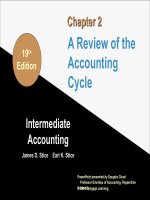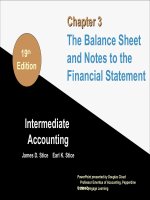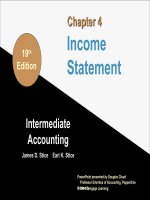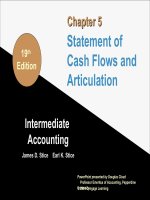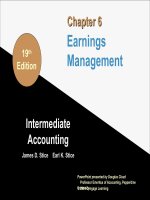Intermediate accounting 19th by stice stice chapter 16
Bạn đang xem bản rút gọn của tài liệu. Xem và tải ngay bản đầy đủ của tài liệu tại đây (228.26 KB, 57 trang )
Chapter 16
19th
Edition
Income Taxes
Intermediate
Accounting
James D. Stice
Earl K. Stice
PowerPoint presented by Douglas Cloud
Professor Emeritus of Accounting, Pepperdine
University
© 2014 Cengage Learning
16-1
Deferred Income Tax Overview
•
Corporations in the United States compute
two different income numbers:
Financial income for reporting to
stockholders and
Taxable income for reporting to the
Internal Revenue Service (IRS).
(continued)
16-2
Deferred Income Tax Overview
• The primary goal of financial accounting is to
•
provide useful information to management,
stockholders, creditors, and others properly
interested; the major responsibility of the
accountant is to protect these parties from
being misled.
The primary goal of the income tax system is
the equitable collection of revenue.
(continued)
16-3
Deferred Income Tax Overview
The difficulty of determining what is “income
tax expense” stems from two basic
considerations:
1. How to account for revenues and
expenses that have already been
recognized and reported to shareholders
in a company’s financial statements but
will not affect taxable income until
subsequent years.
(continued)
16-4
Deferred Income Tax Overview
2. How to account for revenues and
expenses that have already been
reported to the IRS but will not be
recognized in the financial statements
until subsequent years.
16-5
Example 1: Simple Deferred
Income Tax Liability
• In 2013, Ibanez Company earned revenues of
•
•
$30,000. Ibanez has no expenses other than
income taxes.
In this case, the income tax law specifies that
income is taxed when received in cash and
that Ibanez received $10,000 in 2013 and
expects to receive $20,000 in 2014.
The income tax rate is 40% and it is expected
to remain the same into the foreseeable
future.
(continued)
16-6
Example 1: Simple Deferred
Income Tax Liability
The journal entry to record all the tax-related
information for Ibanez for 2013 is as follows:
Income Tax Expense
Income Taxes Payable
Deferred Tax Liability
12,000
4,000
8,000
$30,000 × .40
$4,000 current year
+ $8,000 deferred
(continued)
$10,000 × .40
$20,000 × .40
16-7
Example 1: Simple Deferred
Income Tax Liability
Ibanez Company
Income Statement
For the Year Ended December 31, 2013
Revenues
Income tax expense:
Current
Deferred
Net income
$30,000
$4,000
8,000
12,000
$18,000
16-8
Example 2: Simple
Deferred Income Tax Asset
• In 2013, its first year of operation, Gupta
•
•
Company generated service revenues totaling
$60,000, all taxable in 2013.
No warranty claims were made in 2013, but
Gupta estimates that in 2014 warranty costs of
$10,000 will be incurred for claims related to
2013 service revenues.
Assume a 40% tax rate and that Gupta
Company had no expenses in 2013 other than
warranty costs and income taxes.
(continued)
16-9
Example 2: Simple
Deferred Income Tax Asset
The journal entry to record all the tax-related
information for Gupta for 2013 is as follows:
Income Tax Expense
Deferred Tax Asset
Income Taxes Payable
$24,000 current year –
$4,000 deferred
(continued)
20,000
4,000
24,000
$50,000 × .40
$10,000 × .40
$60,000 × .40
16-10
Example 2: Simple
Deferred Income Tax Asset
Gupta Company
Income Statement
For the Year Ended December 31, 2013
Revenues
Warranty expense
Income before taxes
Income tax expense:
Current
Deferred benefit
Net income
$60,000
10,000
$50,000
$24,000
(4,000)
20,000
$30,000
16-11
Permanent and Temporary
Differences
Permanent differences are created by political
and social pressures to favor certain segments
of society or to promote certain industries or
economic activities.
Nontaxable revenue—proceeds from
insurance policies; interest received on
municipal bonds
Nondeductible expenses—fines for
violations of laws; payment of insurance
premiums
(continued)
16-12
Permanent and Temporary
Differences
More commonly, differences between pretax
financial income and taxable income arise from
business events that are recognized for both
financial reporting and tax purposes but in
different time periods. These differences are
referred to as temporary differences.
(continued)
16-13
Permanent and Temporary
Differences
•
The first category includes differences,
called taxable temporary differences, that
will result in taxable amounts in future years.
•
The second category includes differences,
called deductible temporary differences,
that will result in deductible amounts in
future years.
16-14
Illustration of Permanent and
Temporary Differences
•
The permanent differences are not
included in either the financial income
subject to tax or the taxable income.
•
Permanent differences have no impact on
income taxes payable in subsequent
periods.
•
In general, the accounting for temporary
differences is referred to as interperiod
tax allocation.
16-15
Annual Computation of Deferred Tax
Liabilities and Assets
•
FASB ASC Topic 740 reflects the
Board’s preference for the asset and
liability method of interperiod tax
allocation, which emphasizes the
measurement and reporting of balance
sheet amounts.
•
One drawback of this method is that in
some ways, it is still too complicated.
(continued)
16-16
Annual Computation of Deferred Tax
Liabilities and Assets
The major advantages of the asset and liability
method of accounting for deferred taxes are as
follows:
1. Assets and liabilities are recorded in
agreement with FASB definitions of financial
statement elements.
2. This method is flexible and recognizes
changes in circumstances and adjusts the
reported amounts accordingly. This flexibility
may improve the predictive value of the
financial statements.
(continued)
16-17
Annual Computation of Deferred Tax
Liabilities and Assets
Identify type and amounts of existing
temporary differences.
Measure the deferred tax
liability for taxable
temporary differences (use
enacted rates).
Measure the deferred tax
asset for deductible
temporary differences (use
enacted rates).
Establish valuation allowance account if more
likely than not some portion or all of the
deferred tax asset will not be realized.
16-18
Example 3: Deferred Tax Liability
• For 2013, Roland computes pretax financial income of
•
$75,000. The only difference between financial and
taxable income is depreciation.
Roland uses the straight-line method of depreciation for
financial reporting purposes and ACRS on its tax return.
(continued)
16-19
Example 3: Deferred Tax Liability
The enacted tax rate for 2013 and future years
is 40%. Roland’s taxable income for 2013 is
$60,000, computed as follows:
Financial income subject to tax
Deduct temporary difference:
Excess of tax depreciation ($40,000)
over book depreciation ($25,000)
Taxable income
Tax ($60,000 x 0.40)
$75,000
(15,000)
$60,000
$24,000
(continued)
16-20
Example 3: Deferred Tax Liability
Roland’s
Roland’sJournal
JournalEntry
Entryfor
for2013
2013
Income Tax Expense
Income Taxes Payable
Deferred Tax Liability—
Noncurrent
30,000
24,000
6,000
$30,000 – $6,000
$24,000 current + $6,000 deferred
$15,000 × .40
(continued)
16-21
Example 3: Deferred Tax Liability
Income taxes would be shown on Roland’s
2013 income statement as follow:
Income before income taxes
Current
Deferred
Net income
$75,000
$24,000
6,000
30,000
$45,000
The December 31, 2013, balance sheet
would report a current liability of $24,000.
16-22
Example 3: Deferred Tax Liability
Roland earns financial income of $75,000 in each
of the years 2014 through 2016. Roland reports
taxable income of $70,000, computed as follows:
Financial income subject to tax
Deduct temporary difference:
Excess of tax depreciation ($30,000)
over book depreciation ($25,000)
Taxable income
Tax ($70,000 × 0.40)
(continued)
$75,000
(5,000)
$70,000
$28,000
16-23
Example 3: Deferred Tax Liability
Roland’s
Roland’sJournal
JournalEntry
Entryfor
for2014
2014
Income Tax Expense
Income Taxes Payable
Deferred Tax Liability—
Noncurrent
30,000
28,000
2,000
$30,000 – $2,000
$28,000 current + $2,000 deferred
$5,000 x 0.40
(continued)
16-24
Example 3: Deferred Tax Liability
Depreciation expense in 2015 is the same for
both financial and tax, so the entry is simple.
Income Tax Expense
Income Taxes Payable
30,000
30,000
$75,000 × 0.40
(continued)
16-25


